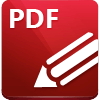 Macros
Macros
Macros are used in several of the tools and actions of PDF-XChange Editor. 'Macro' is an abbreviation of 'macroinstruction' - a term in computer science for a rule or pattern that specifies how an input sequence of characters should be mapped to create a corresponding output sequence. This means that components of the output process can be reduced in the input process, making the work involved both less intensive and less error-prone. Input macros usually relate to the names of saved files - I.e. macros are used in the file name when saving files and the name of the resulting file updates with the information that corresponds to the macro.
When macros are available the ![]() icon is visible next to the Save File dialog box. See here for a list of macro-enabled operations. Click the icon and select the macro from the list to add it to the file name.
icon is visible next to the Save File dialog box. See here for a list of macro-enabled operations. Click the icon and select the macro from the list to add it to the file name.
The macros available in PDF-XChange Editor are used predominantly when saving stamps, watermarks and other documents. The format for macros is:
%[<Macro Name>] or, when it is customizable: %[<Macro Name>:<Parameter>]. The <Parameter> step is optional. All macros are detailed below:
•Date
•Year
•Day
•Time
•Hour
•Environment Variable, which has multiple options relating to the environment variables of the file.
See here for a technical explanation of how macros function.
Please note that certain symbols are not compatible with macros and therefore are not permitted in document names. If inconsistencies are noticed between the name used when files are saved and the final file name then it is advised to change the name used when files are saved.